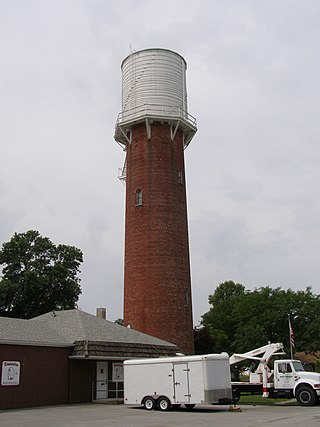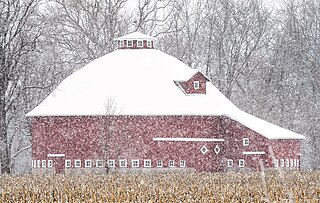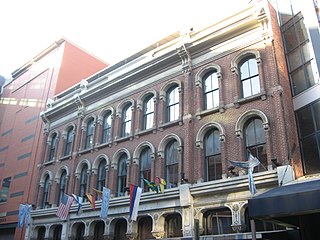
Eleutherian College, which was listed on the National Register of Historic Places in 1993 and declared a National Historic Landmark in 1997, was founded as Eleutherian Institute in 1848 by a group of local anti-slavery Baptists at Lancaster in Jefferson County. The institute's name comes from the Greek word eleutheros, meaning "freedom and equality." The school admitted students without regard to ethnicity or gender, including freed and fugitive slaves. Its first classes began offering secondary school instruction on November 27, 1848. The school was renamed Eleutherian College in 1854, when it began offering college-level coursework. It is the second college in the United States west of the Allegheny Mountains and the first in Indiana to provide interracial education. The restored three-story stone chapel and classroom building was constructed between 1853 and 1856 and presently serves as a local history museum.

The Old Jeffersonville Historic District is located in Jeffersonville, Indiana, United States. It marks the original boundaries of Jeffersonville, and is the heart of modern-day downtown Jeffersonville. It was placed on the National Register of Historic Places in 1983. The area is roughly bounded by Court Avenue at the North, Graham Street on the east, the Ohio River at the south, and Interstate 65 at the west. In total, the district has 203 acres (0.8 km2), 500 buildings, 6 structures, and 11 objects. Several banks are located in the historic buildings in the district. The now defunct Steamboat Days Festival, held on the second weekend in September, used to be held on Spring Street and the waterfront. Jeffersonville's largest fire wiped out a block in the historic district on January 11, 2004 which destroyed the original Horner's Novelty store.

The Kintner–Withers House, also known as Cedar Farm, is on the National Register of Historic Places, south of Laconia, Indiana, along the Ohio River in Boone Township, Harrison County, Indiana. Jacob Kintner, aided by his wife Elizabeth, built the structure in 1837. It is one of only 2 "antebellum plantation-style" complexes known to remain in Indiana, comprised originally on 600 acres (240 ha) of land. It is believed that Kintner was inspired to build this after sailing on the Mississippi River to New Orleans.

The Water Tower was built in 1897 by Challenge Wind and Feed mill Company of Batavia, Illinois. This is a rare wooden tank atop a brick tower type of water tower. Built on a limestone foundation, it is 140 feet (43 m) tall and about 20 feet (6.1 m) in diameter. The brick walls are 2 feet (0.61 m) thick.

The Millen House is a historic residence on the campus of Indiana University in Bloomington, Indiana, United States. Built by an early farmer, it is one of Bloomington's oldest houses, and it has been named a historic landmark.

The Cottage Home Historic District is a historic district and neighborhood located on the near east side of Indianapolis, Indiana. A small portion of Cottage Home is listed on the National Register of Historic Places while a larger area is listed on the state and local levels. Known for its preponderance of "cottage-style" homes built with strong Victorian influences, Cottage Home has historically been a working class neighborhood. Numerous industrial buildings are also scattered throughout the district, providing a base of economic activity. Today, however, many of these buildings are vacant, providing a special challenge to preservation and urban renewal efforts.

The Republic is an American daily newspaper published in Columbus, Indiana, United States. It is owned by AIM Media Indiana, a subsidiary of AIM Media.

The John Haimbaugh Round Barn in Newcastle Township near Rochester, Indiana, United States, is a round barn that was built in 1914. It was listed on the National Register of Historic Places in 1993.

New Haven station is a historic train station located at New Haven, Allen County, Indiana. It was built in 1890 by the Wabash Railroad. It is a one-story, wood-frame building, with Stick Style / Eastlake movement ornamentation. It measures approximately 50 feet long and 20 feet wide and has a gable roof and board and batten siding.

Carmel Monon Depot, also known as Monon Depot Museum, is a historic train station located at Carmel, Hamilton County, Indiana. It was built in 1883 by the Monon Railroad, and is a one-story, rectangular frame building measuring 45 by 18 feet. It has a gable roof with wide overhanging eaves. It originally served as a passenger station and freight depot until services were discontinued in 1961 and 1974, respectively. It was moved to its present location in 1980, and in 1981 a 20-by-18-foot addition was constructed. The building was subsequently renovated and houses a local history museum.

Lyman and Asenath Hoyt House is a historic home located at Lancaster Township, Jefferson County, Indiana, and owned by the non-profit group, Historic Eleutherian College Incorporated. Built about 1850, the two-story, rectangular, limestone dwelling has Greek Revival-style design elements. Its front facade has gable roof and a deep-set wooden entry door.

Francis P. Keilman House is a historic home located at St. John, Lake County, Indiana. It was built about 1857, and is a two-story, side hall plan balloon frame dwelling with Italianate style design elements. It has a front gable roof and a rear addition built about 1900. Also on the property are the contributing wood frame stable with a garage addition and a wood frame rabbit hutch.

Plymouth Downtown Historic District is a national historic district located in Plymouth, Marshall County, Indiana, United States. The district encompasses 47 contributing buildings and one contributing structure in the central business district of Plymouth. It developed between about 1870 and 1940, and includes examples of Italianate, Romanesque Revival, and Colonial Revival style architecture. Located in the district is the separately listed Plymouth Fire Station. Other notable buildings include the Montgomery Ward Building (1929), Metsker Block, Rentschler Building (1910), Early Plymouth Post Office (1884), First National Bank-Plymouth City Hall, Packard Bank Block (1879), Simons Building (1895), Wheeler Block, Bank Block, Bank Block-Masonic Temple (1901), Plymouth Post Office (1935), and Plymouth Motor Sales (1929).

Bethel AME Church of Crawfordsville is a historic African Methodist Episcopal church located at Crawfordsville, Montgomery County, Indiana. It was built in 1892, and is a one-story, gable fronted frame building on a brick foundation. It features a large round-arched window and two-story, square corner tower. Portions of the building are believed to date to 1847. Also on the property is a contributing one-story, Queen Anne style cottage that served as the original parsonage.

Monterey Bandstand, also known as Kleckner Park Bandstand, is a historic bandstand located at Monterey, Pulaski County, Indiana. It was built in 1912, and is a wood-frame structure measuring 12 feet, 6 inches, wide, and 20 feet long. It is raised on 30 inch high piers. The building has a hipped roof and exhibits Queen Anne style design elements. The bandstand was restored in 1979.

Curtis–Grace House, also known as the Roy and Leona Curtis House and Richard and Connie Grace House, is a historic home located at West Lafayette, Tippecanoe County, Indiana. It was built in 1958, and is a two-story, banked, post-and-beam Modern Movement style dwelling, with a broad, low-pitched offset gable roof. It is constructed of concrete block, redwood, natural stone, and plate glass. The overall dimensions are approximately 82 feet by 23 feet. The surrounding landscaped property is a contributing site.

Administration Building, Indiana Central University, also known as Good Hall, is a historic building located at the University of Indianapolis, Indianapolis, Indiana. It was built in 1904, and is a 3+1⁄2-story, Classical Revival style red-brick building. It measures approximately 127 feet by 150 feet and features a colossal two-story portico supported by Ionic order columns. It has two-story flanking wings and a porte cochere.

L.S. Ayres Annex Warehouse, also known as Elliott's Block Nos. 14-22, is a historic warehouse building located at Indianapolis, Indiana. It was built in 1875 by the L.S. Ayres department store, and is a three-story, rectangular Italianate style brick building with an elaborate cast iron first story storefront. Other decorative elements are in stone, brick, and sheet metal. It measures 72 feet, 6 inches, wide and 49 feet, 6 inches, deep. It features Corinthian order columns as part of the cast iron facade.

Rink's Womens Apparel Store, also known as the Rink Building, is a historic commercial building located at Indianapolis, Indiana. It was built in 1910, and is a six-story, rectangular, steel frame building sheathed in clay tile and masonry. It measures approximately 120 feet by 70 feet and is four bays wide by seven long. It features large Chicago style window openings. The building housed the Rink's Womens Apparel Store, in operation until 1939.

Rose Hill Farmstead, also known as the Rose—Wise—Patterson Farm, was a historic home and farm located near Vincennes in Palmyra Township, Knox County, Indiana. The original farmhouse as built in 1807 by Martin Rose. This house was replaced in 1827 by a two-story, Federal style brick I-house which was built by Rose's son, Matthias Rose. It had a rear ell added in 1829 and was remodeled about 1890. Also on the property were a contributing silo, summer kitchen, two barns, garage chicken coop, and tool or storage shed. It has been demolished.























